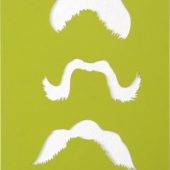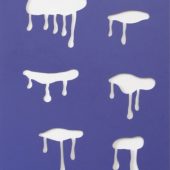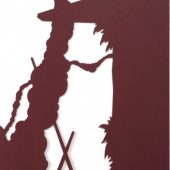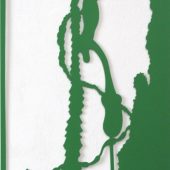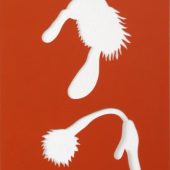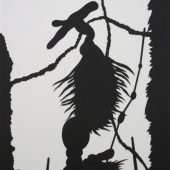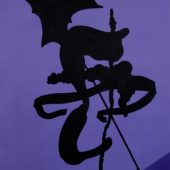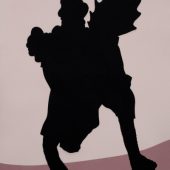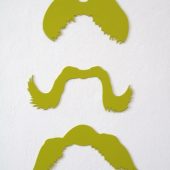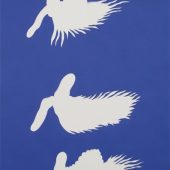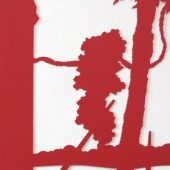08.28 — 10.08.11
For more than 25 years, Cologne-based artist Volker Saul has been amassing an extensive internal database of organic and body-suggestive imagery that continually morphs to satisfy the needs of the most current project. The result of that processing is remarkably varied — drawings, paintings, sculptures, installations, site-specific wall paintings and public sculpture. The pieces presented in Rough Cuts are resolute; the new forms are concentrated, cut out, compositionally efficient and offered up in an emblematic or heraldic presentational format. This laser-cut aluminum work offers a very rich visual and conceptual experience for the viewer. The material is machined to perfection, but the images are provocative and not always with the most appealing associations. Internal organs, appendages, insects, plant forms, and prickly surfaces carry on in exotic circumstances. The results are graphically satisfying but also peculiar, much like the way a disturbing dream troubles well after the images evaporate.
Since the mid-80s, Volker Saul has made site-specific wall paintings and works which operate in the interstitial space between image and object. He has had solo exhibitions at Galerie Caren Jones in Cologne; Nagoya at Gallery HAM in Paris; at Galerie Gutharc-Ballin in Auckland: at City Art Rooms among others. His work has been featured at the Rheinisches Landesmuseum Bonn; the Japan Cultural Institute in Cologne; the Leopold Hoesch Museum Düren; the Dortmunder Kunstverein; and the Kunstverein Mönchengladbach. In the U.S. he was included in group exhibitions at the Pratt Institute in NY and the Zolla Lieberman Gallery in Chicago. He has received the Günther and Carola Peill scholarship, the Kunstpreis des Kreises Düren, and the Euregio Art Award from Kleve. Volker Saul is featured concurrently in K.O.F.G.A., a solo exhibition at the Gahlberg Gallery at the College of DuPage in Glen Ellen, Illinois. The exhibition opens on Thursday, August 25 from 6 – 8 pm.
TAXONOMIC MIRABILIA—on Volker Saul’s graphic vocabulary
An essay by Harald Uhr for the K.O.F.G.A exhibition at the Gahlberg Gallery at the College of DuPage
No matter how abstract an image is, the unsuspecting observer can, even must whisper: “This reminds me of…!” to their accompaniment. No one can deny them this. Moreover no one can decline the legitimacy of such a comment. In fact, it would prove nearly impossible to find anything on this globe, which cannot be placed into some kind of relationship to something else. This is particularly so for works of art. After all, art itself consistently seeks points of reference outside of its own realms, but also gladly ones within its own metier. Furthermore, art benefits from the fact that we live in an age practically greedy for images; an age which spares no efforts to make even the most distant objects or circumstances visible. Probes are shot into the vast expanse of outer space to deliver us grainy or pin sharp images of whatever. The tiniest particles, microbes, and nuclei are enlarged until the eye believes it perceives something it can process or at least recognize at the next opportunity. We hoard visual databases, even at the risk of not being able to interpret the accumulated or produced images at the present point in time. Sometimes it seems as though we are constantly gathering answers in pictorial form, without yet being able to properly formulate the corresponding questions. But these have always been familiar grounds for art, which lives to a great extent on the openness of possible interpretations of what is presented to the eye.
We can confidently assume that whilst observing Volker Saul’s drawings and pictures, associations will arise. Some of these may be bizarre or even monstrous, yet they are able to claim for themselves a certain quantum of plausibility or connectivity. We are not likely to be able to refer back to the familiar pool of objects presented to us at eye level on a daily basis, though we can refer back to various segments of our accumulated pictorial archives. As we align images, we might come across illustrations from scientific textbooks. Displays with images of the insides of the human body might present themselves. Depictions of nerve paths, ganglia, or synapses can be drawn into comparison. In any case, Saul’s drawings appear organic but at the same time schematic, which is certainly a familiar concept from biology class.
At this point the title of the exhibition pushes itself strikingly into our consciousness: ‘K.O.F.G.A’ – this seemingly strange order of letters denotes nothing less but a mnemonic in the field of taxonomy: the scientific classification of organisms in accordance with international rules of nomenclature. The abbreviations stand for “Klasse, Ordnung, Familie, Gattung, Art” (Class, Order, Family, Genus, Species) and suggest complete definability of all living organisms. This, however, in daily practice, even with schooled specialists – not to mention in school itself – does not even come close to providing the desired accurate or definite results. But even in the dry field of science we are allowed to maintain a certain amount of freedom. For the much less dry field of art this freedom is almost indispensable. We cannot deny that Volker Saul’s graphic vocabulary possess a distant mimetic capacity. But it is also the playing material from which new constellations arise again and again.
Not without content or connection to the world, the elements of Saul’s pictures are color- and form-signals without a message. They float about freely, seeking balance not dominance. They are able to exist alongside of one another; they are related to one another and can be grouped together on the wall. They are made up of a multifaceted combination of modular structures, each of which seeks visual stability for itself. We are told of the continuum of images, sequences, and clusters. Their arrangement stems from an arsenal consisting of an indiscernible number of elementary formulations.
The Cut Outs and the larger works – on paper, tarpaulin or wall space – emerge from hand drawings. Digital processing leads to two-dimensional shapes, reminiscent of emblems, partially on colored background. The palette ranges from pastels to warning colors. Immediately one gets the impression of an emblematic and heraldic adaptation. On the red surface, for example, the shapes look like warnings signs. But what might they be warning us of? As was the case with the drawings, here too, we make associations with organic proliferating shapes. If the taxonomists occupied themselves with this they would be sure to write down the most adventurous descriptions of various small organisms or cell accumulations on their classification lists. In the end a germ warning might be called out. Or acarids, bugs and microbes, parasites and bacteria, all kinds of pathogenic agents might display their silhouette in million-fold magnification. Of course these are just random associations, but one can certainly not help but feel a bit queasy whilst looking at these hybrid shapes. Whilst in earlier times it was probably the illustrated portfolios of plates, as forerunners of the enlightenment, with their mirabilia and curiosities from far away lands which kindled the observer’s imagination, today it is the 3D animations for the great Hollywood shockers, which satisfy what seems to be our need for bizarre creepiness. To create greater suspense, things which remain invisible to the human eye, are often exaggerated to become over-sized. Some pre-morphous pushing and shoving suddenly appears as a body eater, striving for world domination and disturbing an innocent suburbanite’s peace of mind. He had always been able to live a harmonious life with his housemates, as long as they had remained the size bestowed upon them by creation, and thereby entirely hidden from the view of human beings. One does not need to follow these morbid associations through to the very last detail.
The less nervously tense among us, might be reminded of peaceful wild herbs growing in the Tyrolese Alps and upon observation might already be able to taste the honey hardworking bees will make from their nectar. In any case, we can be sure of the twinkle in Volker Saul’s eye, as he gladly puts up with the emotionally exuberant reactions of the observers of his works. He is interested in the discrepancy between the sober and formal order of nearly uniform marks and lines and the complex emotional states, which these can trigger once they have grown to full figures.
Volker Saul’s art gives up concrete representation in favor of the presentation of detailed elements and moments. “Yet it is precisely through its diffusion that art can be equated with being as a capacity of the possible, or language as a capacity of recreation.” (Lyotard). Art as an experiment, provides ever new horizons, and functions as a permanent sense of possibility. And through this possibility art reaches beyond itself time and time again. The actuality of a work of art, which affects the viewer sensually, is expanded by the anticipation of the unconditional, which shakes the individual in his established scope of experiences. Volker Saul’s painting systemizes actuality as the place of failed reality. The works of art become spaces of reflection, which leave open the multitudes of possible interpretations. They accentuate the disparities of apparent realities. Saul is radical in his approach and consistent in his questioning of the concept of the image. Nonetheless the artist is aware of the multiple intertwined relations to the world outside of the aesthetic autonomy of art and consciously sets his adventurous works in this ambivalent transition zone. Whilst initially they appear rationalizing, systemizing, and objective, they are never free of the utmost subjectivity.
Even counter-worlds have points of reference, when they undermine, in an excitedly puzzling way, the rational reference axes of what we call reality. This is proven by a look at Volker Saul’s work in and handling of the room. The formulations applied to the tarpaulin give the draped tableau a relief-like character and develop into an object-like image, which shines out into the room. The thus assembled shapes communicate with one another in rich and complex ways, whilst seemingly approaching the viewer. The shape of the image, the frame of presentation, the surface, and room form an inseparable entity. The variety, which follows no set order but the construction of which is comprehensible and readable, awards the figures beauty and lightness. They invite visual reflection and at the same time overwhelm us with their laconic directness. These works are exemplary of the artist’s playful and humorous handling of the parameters of non-objective and nonrepresentational art. They can be seen as an examination of the uses of form, color, lines, light, space, and material. In a very differentiated manner, Saul analyses primarily mixed conditions, arrangements, and links. He does not analyze abstraction itself, as some detached entity. This raises the demand, that the eye do remain set on things, but becomes aware of its sense of sight and raises itself to the visible. Saul places his main focus of attention on the development of visual conditions, which attaches substantial significance to gradual understanding. To the same degree as his works want to communicate aesthetically, they refuse to prescribe the how and what to the observer. The image is ultimately of this world. We are in the same room, in which we bear witness to the silent presence of serialized materials, form, and color. Abstract art itself is in the end a tradition amongst others and the handling of non-representative forms has become one aesthetic model amongst many.
For Volker Saul each new location for his exhibitions presents a new stage to be played upon. The walls, ceilings and floors make up the set, which is only partially accepted as a limitation. The arabesques and grotesques let us experience the stark walls as vivid and pulsating projection spaces. His claims on the room, which go as far as the graphical transformation of realities of their own order, can be read as variations of the strange, as subversive parasites in the allegedly structured system of mimesis. The line is not merely an optical fact in this. It is the first versatile action. It divides and connects, delineates and orders, spans and designs. The disparate contents of these shapes – the amorphous, the chaotic growth, and the set linear – preserve in themselves the dialectic which prevents us from being banned into the one reality.
The sensual aspects raise questions about our perception as well as the understanding of the body. Furthermore, with the help of the two-dimensional artistic medium, wishes and visions can be transformed into descriptive, promising or fearful images. Hereby rational thinking includes its own eventfulness in its reflections.
The world-known concept of graphical thinking encounters a process of processes in which a world is composed, concentrated, experienced, hard- won, endured, agreed upon, implemented, and thought. Volker Saul’s protruding form-findings can therefore also be referred to as scenographies. This type of presentation enables a view onto and around corners, in any case a multi-dimensional view. A picture is something which is painted to be available and gives the option to be used.
Harald Uhr
Harald Uhr (b. 1961) is an art historian, independent author and curator. 1997-2005 research associate and curator at the Bonner Kunstverein. 2005-2010 independent curator for the Stiftung Kunstfond Bonn. 2005/06 lectureship at the Staatliche Akademie für Bildende Künste Stuttgart. Author of numerous essays and catalog contributions on contemporary art.
Translation by Ayken-Konstanze Spura (b. 1983) BA in History of Art and History, and MA in Modern History from the University of East Anglia, Norwich. Has lived in the US, Norway, and England. Currently living and working in Nordenham, Germany.
